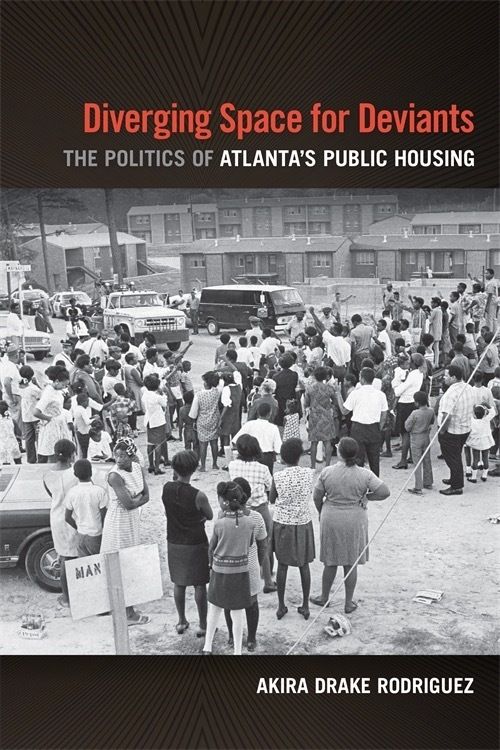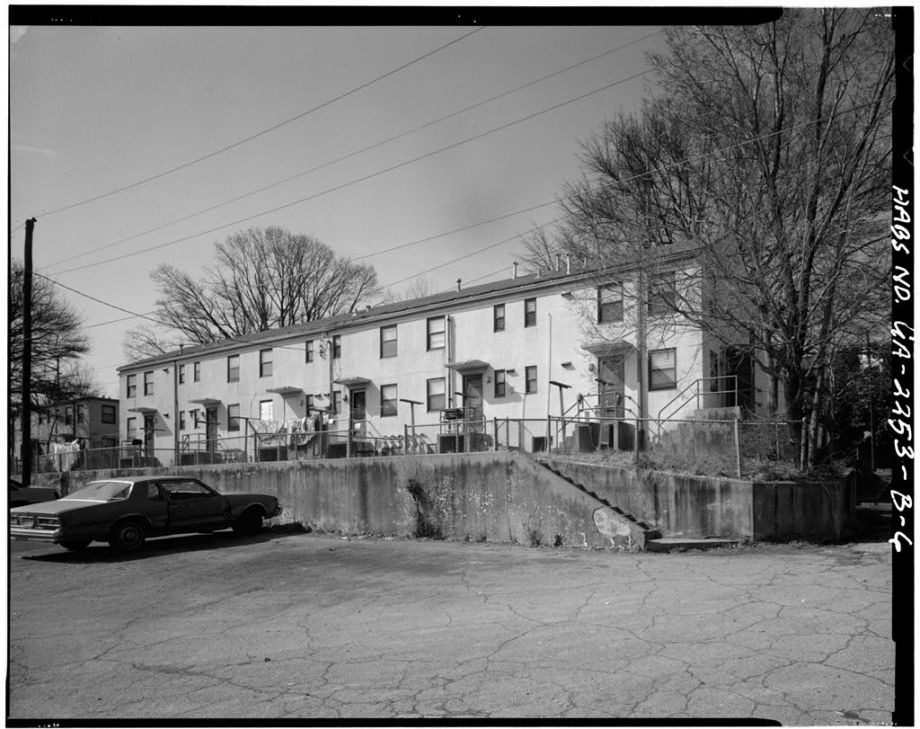The City of Atlanta opened its first public housing development in 1936 and demolished its last one in 2011. Both its creation and its demise were pushed forward by a biracial coalition of civic and business leaders, with public housing first seen as a solution to a problem and later as a problem to be solved through demolition and redevelopment. At times during the 75-year interim, though, public housing tenants, particularly Black women, found ways to use the structures of public housing to access public resources and advocate for their interests, writes Akira Drake Rodriguez in her new book, Diverging Space for Deviants: The Politics of Atlanta’s Public Housing. The housing developments were a type of “political opportunity structure” for people whose interests were not well-represented by the city’s ruling political coalition, Rodriguez writes.
“Without the restrictions of uplift ideology, religious morality, and respectability politics structuring political opportunities, more deviant Black interests had the ability to assert power through public housing developments,” Rodriguez writes. “New political norms, tactics, and strategies emerged to complement this more radical assemblage of interests for Black social and spatial justice.”
Rodriguez, an assistant professor of city planning at the University of Pennsylvania Weitzman School of Design, writes that she became interested in the story after reading a news article about the city tearing down its last public-housing development a decade ago. (Full disclosure: I also do part-time, seasonal work for the Weitzman School.) Tracing the development and decline of public housing in Atlanta, she explores how racism and white supremacy isolated the city’s public-housing developments and constrained their benefits, but also created unique organizing opportunities for marginalized people. Rodriguez recently spoke with Next City about her research, and what she hopes contemporary tenant organizers will take from it. The conversation has been edited.
You describe the coalition of civic leaders that established public housing in Atlanta in the early days as being tenuous. Who was part of that coalition and why was it untenable?
This was a coalition that came out of crisis. It was people who were major landowners, who had control of the city coffers, legislators and business owners, as well as this kind of progressive arm, a lot of reformers, a lot of religious and social workers, in addition to the trades. You see a lot of construction workers and trades workers coming together to support this project of public housing. And that coalition fell apart once the value of public housing and the public housing tenant began to decline. Once there was no more public housing to construct at a wide scale, once it became clear that the slum clearance project was not enough to save downtown property values, that coalition essentially fell apart immediately. Once all the federal funding and subsidies dried up was when suddenly it was not an attractive program anymore.

(Photo courtesy Akira Drake Rodriguez)
White supremacy translated into how public housing was structured, but also how it was managed, and it eventually led to its demise. The white supremacist, heteronormative, patriarchal categories of the nuclear family were used to establish an early categorization of the deserving and undeserving poor. Areas were targeted as slums or blighted based on which categories of poor lived there, and there were programs and mortgages and lending policies of course to attract the deserving poor into different areas, away from the undeserving poor. Once that project was successful, and the undeserving poor had more access to public housing, suddenly the project is [considered] a failure. Suddenly they are “The Projects.” They’re no longer even considered housing, they’re considered projects. The people who live in them are stigmatized and targeted once again for blight and demolition. White supremacy certainly shapes and therefore limits the efficacy of the public housing program as it currently exists.
The housing developments you describe tended to isolate residents in communities that didn’t have many amenities and were cut off from the rest of the city by various built and natural barriers. But they also created space for political organizing. What were some of the things that public housing tenants’ associations organized around?
The things they organized around are actually pretty basic. These developments didn’t have basic infrastructure around them. Sidewalks, traffic lights, speed bumps, stop signs, some sort of security — not necessarily policing, but like a crossing guard that could get kids to the bus safely — libraries, schools. All of these things essentially had to be created out of thin air because when they moved in, particularly in the ‘50s and ‘60s, those amenities were not there. And as a result of where they were located, in the Northwest, around other forms of subsidized or low-cost housing and private rental and market-rate housing that was predominantly Black, they were creating these infrastructures and outcomes for everyone. These things were able to service the entire neighborhood. So I like to think that these were the tenants associations’ wins, but the impacts were for much more than the tenants.
Right now I’m looking at public schools, and I definitely see the spaces of public schools, whether home-and-school associations or parent-teacher associations and other forms of organizing, allowing people to mobilize around resources for public goods and benefits for a specific group that’s been marginalized.

(Book cover courtesy UGA Press)
How did perceptions of Black women in public housing influence the trend away from public housing in the 80s and 90s?
Certainly the trope of the welfare queen was created after the program started to decline. By the 1970s the buildings had been around for at least 20 years, but for most of them more like 40 years in Atlanta. Things were not coming back, and it was certainly easier to blame the tenant. There were more children in these apartments. There was less work, so the wages declined for the tenants and the operating revenues declined for public housing. And they continued to associate those problems with the tenant. This has always been an issue in public housing. You can see it now with landlords as well: “Tenants don’t know how to take care of things, they don’t own it so they don’t care about it.” When you have that idea coming, and then you have the context of the 1980s where employment is very low and wages are stagnating and things are getting really difficult with crime, suddenly the idea of criminalizing the tenant becomes quite popular. You see increases in evictions. You see those neoliberal policies that were not only about privatization but also really about kicking people out. It’s about getting expensive units off of the state’s books, but also getting expensive or “problem” tenants out of public housing.
So you can see that relationship: These women are causing trouble, and these women are a good scapegoat for what’s happening. But the issue of criminalizing the tenant is something that, from the first public housing in the 1930s, I have records of people getting kicked out of public housing for having a broken home or a broken family. There was a lot of stigma around the failure to conform to the nuclear family norms.
And so the increased political organizing and activity of Black women in public housing, did that also have a nexus to that characterization and that disinvestment?
For sure. The white men in power who ran these housing authorities did not like having to answer to these Black women. As they grew in their population and their organizing strength, they became pretty organized. They were doing rent strikes — a whole wave of rent strikes in 1967. In the 1970s you start to see the creation of the problem tenant and the welfare queen, following all of that activism. There were very visible, prominent activists at local and national levels that helped to foment this backlash.
How did the 1996 Olympics accelerate the disinvestment and clearing of public housing in Atlanta?
Much like the New Deal and this sort of coalition of people who were not really friends you had a similar bond emerge in ‘96 where you get even Black women tenants who are in favor of demolishing public housing and rebuilding it, getting all the criminals out, bringing the cops in, getting rid of the homeless, a lot of these issues from all those years of the stigma of welfare recipients of single mothers, et cetera, had really pervaded all the politics of public housing by that point and so the Olympics just provided a ton of money to do it. You see HOPE VI produced around the same time. And it just kind of didn’t stop. They didn’t have to demolish all of the public housing in Atlanta, but they did. And now they have a horrible housing crisis.
You mention that you became interested in doing this research after you read about the demolition of the last public housing property in Atlanta. Can you talk about how the forces that destroyed public housing relate to the forces that created it in the first place?
The overlap, to me, is the failure to account for what the crisis is. The crisis is not that the private market isn’t good at building low-cost housing. This is not a market failure; this is literally the market. The market does not produce this housing. There’s this failure to acknowledge what the problem really is, which is this persistent, deep inequality, and a failure to acknowledge how central race and capital are to organizing our cities.
How do you hope the book is used?
I really want this book in the hands of organizers. A lot of the things that are now happening in tenant organizing are not new things. There are really strong efforts and documentation and networks to help. Especially now that so many renters are in private housing and are disconnected from one another and lack formal tenant associations that are funded by the government, they find that the lack of institutional knowledge and advancing solutions that have been advanced in the past that have not been effective. I’m really happy with the book and I’m really excited about what tenant organizers are doing at the moment. I think this is kind of a wonderful moment in tenant organizing. And we’re still waiting for that eviction cliff. But I very much want those who are working together in the struggle to think broadly and scale up their organizing. My goal is to get more tenant organizers in conversation with one another.
This article is part of Backyard, a newsletter exploring scalable solutions to make housing fairer, more affordable and more environmentally sustainable. Subscribe to our weekly Backyard newsletter.

Jared Brey is Next City's housing correspondent, based in Philadelphia. He is a former staff writer at Philadelphia magazine and PlanPhilly, and his work has appeared in Columbia Journalism Review, Landscape Architecture Magazine, U.S. News & World Report, Philadelphia Weekly, and other publications.
Follow Jared .(JavaScript must be enabled to view this email address)


















